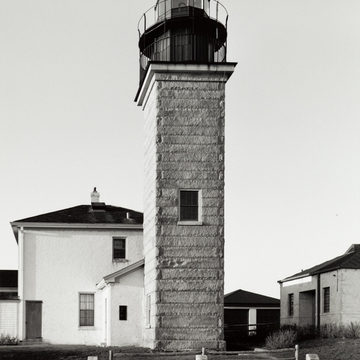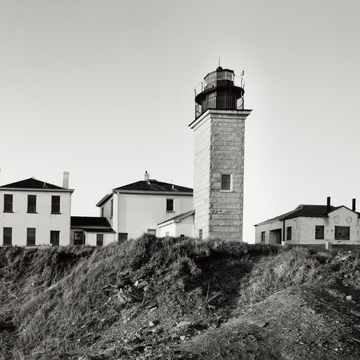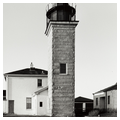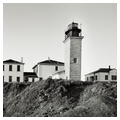The lighthouse, the terminus and ultimate destination for all pilgrims of the Beaver Tail route, marks the entrance to Narragansett Bay. To the approaching mariner, it proclaims, “You have arrived.” It is, moreover, the marker dividing traffic into the bay between its two channels, east and west. Although its automated surrogate in front of it now does the job, and the lighthouse itself, like all others in the state, has been museum-ized, for pilgrims by land and (except for anyone doing the practical work of navigation) even by sea it is still the marker. And appropriately for its privileged position, it even occupies a control location (almost) along Rhode Island's coastline. In the hierarchy of the state's lighthouses, therefore, it can be said to hold the premier position.
After such fanfare, a first view of the unadorned, straight-sided gray granite tower, 10 feet square and 45 feet high, may be disappointing. Surely Block Islanders can justifiably laud their lights at opposite ends of the island as being both more shapely than this one and possibly more picturesquely situated. But despite pedestrian modernized windows, the careless untooled surfaces of the granite masonry, and other gaucheries, Beaver Tail has its qualities. The promontory from which the tower rises extends its impact: jagged and tumbled toward the West Channel, but especially beautiful toward the East Channel, where the rock, water-smoothed and whorled, rounds to the water like a submerging whale or submarine. Framing the lighthouse complex in the camera viewer reveals how handsomely and variously its paired and connected hip-roofed cottages for the keeper and his assistant “compose” against the tower to which they are attached. The spanking white paint of their stucco-covered brick walling and of service buildings nearby contrasts with the gray granite tower. Edward Hopper would have been attracted to such a brusque composition, finding merit in the vigor with which these basic shapes combine, in their blunt functionalism, and in the awkwardness which such straightfoward handling can afford to ignore. This direct approach to the task at hand is nowhere more evident than in the construction of the square tower. It is built of elongated granite blocks eight and ten feet in length, the ten-footers stacked as interlocked cribbing with eight-footers as infill. No other New England lighthouse is constructed in this manner, characteristic of squared-off log building rather than of masonry. The effect is of an immensely secure box raised as a stalwart pylon
This promontory has seen beacons and lighthouses since the early eighteenth century. Colonial records previous to 1756 mention a watch house on the site in 1705; a beacon with a regular watch in 1712; and a wooden tower 59 feet high in 1749. The last, designed by Newport's famed architect Peter Harrison, was only the third lighthouse erected in the colonies. It burned in 1753, leaving behind no recorded image. The first masonry tower, a field-stone affair, which replaced it in 1755, was burned by the British when they evacuated Newport in 1779 and repaired in 1783–1784. It sufficed until the present tower went up in 1856.
Beaver Tail is also notable as the site of a sequence of experiments in light and sonic technology. An unsuccessful effort by David Melville in 1817–1818 to improve oil illumination by heating tar and rosin over a coal fire resulted in the first use of gas as a lighthouse illuminant. And from 1851 it served as a testing place for new types of fog signals ranging from various whistles and reed trumpets operated by compressed air, until these were eventually augmented by a steam whistle in 1881—the first such combination in lighthouse technology. Its fixed white light from an oil lamp became a flashing light in 1899, a flashing electric lamp in 1931, and finally a 45,000-candlepower revolving beam with a green flash and a clear-sky range of seventeen miles.
Automated (since 1972) like most other surviving Rhode Island lights, it is now also maintained as a museum to its own past and to a vanished tradition, as are its cousins on Block Island. They are the three most visited lighthouses in the state.

















